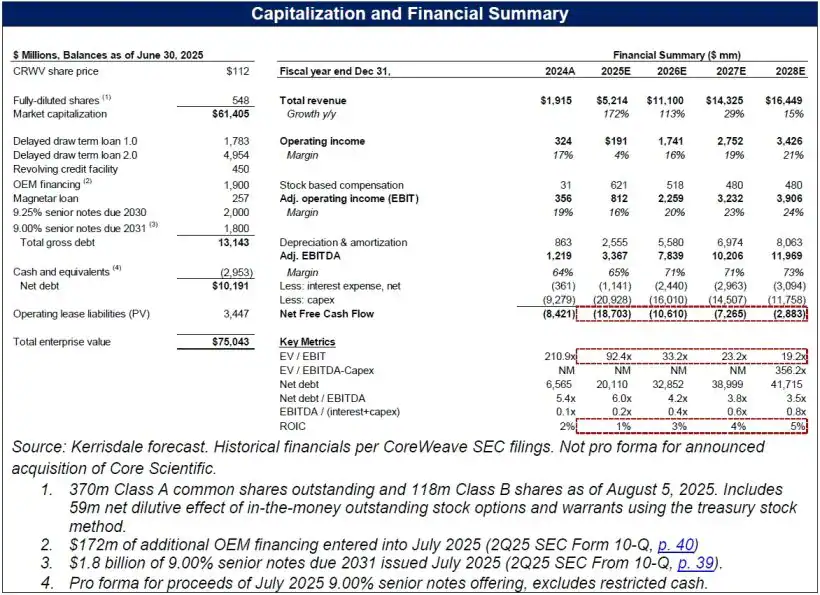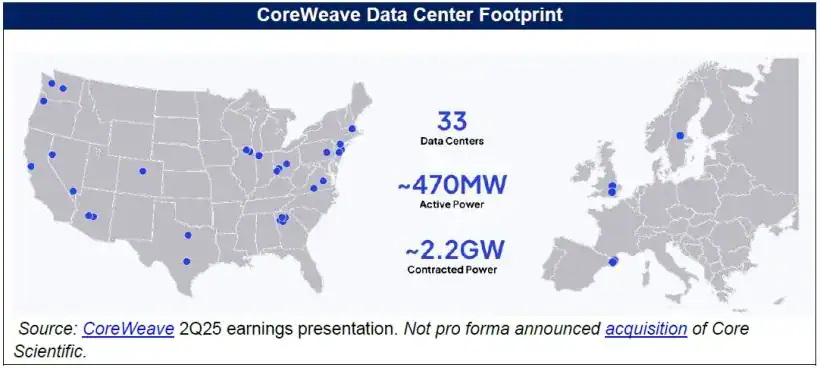Kerrisdale Capital is short shares of CoreWeave Inc (NASDAQ:CRWV), a so-called neocloud that has rallied 30% in just the past week and trades nearly 200% above its IPO price five months ago.
It is the poster child of the AI infrastructure bubble. In three years, CoreWeave has gone from a crypto mining outfit in a founder’s grandfather’s garage to a self-declared “AI hyperscaler” valued at $75 billion. The latest surge rests more on hype, not substance: investors chasing headlines around Microsoft’s new Nebius deal and Oracle’s OpenAI-heavy backlog have glossed over how both involve CoreWeave’s anchor customers awarding large, strategic contracts to competitors. Strip away the noise, and CoreWeave remains an undifferentiated, heavily levered GPU rental scheme stitched together by timing and financial engineering, not lasting innovation.
We fully believe in the transformative power of AI. ChatGPT marked a true inflection point, unleashing a wave of compute demand and reshaping global capital allocation overnight. But CoreWeave is not built to capture the broader ecosystem of developers or mid-sized enterprises. Its model revolves entirely around leasing discounted GPU access to a handful of large customers under long-term contracts structured to support expensive asset-backed debt.
This structure has fueled rapid expansion but leaves CoreWeave dangerously exposed to customer concentration, weak pricing power, and eroding relevance as hyperscalers scale their own infrastructure. CoreWeave has no full-stack platform like the leading clouds; its largest customers view it as a stopgap bare metal assembler. It has no proprietary technology, no defensible IP, and no edge in solving the real constraint: power. Microsoft, which accounts for 70% of revenue, proved the point by passing on an expansion option and instead signing a larger, more strategic contract with Nebius. Demand for compute may be insatiable, but CoreWeave has no unique role in meeting it. Its technology is not differentiated – it is interchangeable.
CoreWeave fails the most basic finance test – it generates returns below its cost of capital, destroying rather than creating shareholder value. Beneath the surface is a fragile financial model built on weak unit economics, expensive debt, and relentless reinvestment. To paper over this, CoreWeave has showcased an “illustrative” contract to sell-side analysts. Our review, including input from a former CoreWeave datacenter engineer, shows equity holders receive nothing during the contract term and are left clinging to residual value from five-year-old chips just to break even.
CoreWeave isn’t pioneering the future of AI – it’s a debt fueled GPU rental business with no moat, dressed up as innovation. Secured lenders clip healthy coupons, while equity investors pray aging chips retain value in an era of rapid obsolescence. Shares should be valued accordingly. We see fair value at $10, 90% downside.
Investment Highlights
Rally Built on Competitors’ Wins. Shares are up 30% in a week on headlines around Microsoft’s $17.4 billion Nebius contract and Oracle’s $317 billion backlog surge. Bulls latch onto the “insatiable demand” narrative and hope a rising tide will lift all boats. The reality is more nuanced: the announcements indicate strong AI demand, but also reveal how CoreWeave lacks differentiation as its anchor customers award large contracts to competitors.
Microsoft’s decision is particularly telling. After declining a $12 billion expansion option with CoreWeave in March, it signed an even larger agreement with CoreWeave’s closest neocloud competitor. Additionally, according to D.A. Davidson, the Nebius capacity will primarily support Azure workloads, not just OpenAI overflow, making it higher-quality business that CoreWeave failed to win. A former Microsoft data center executive we interviewed attributed the pivot to CoreWeave’s reported execution missteps, Nebius’ stronger cloud-computing capabilities, and Microsoft’s push to diversify and de-risk its supply chain.
Oracle’s backlog jump is just as problematic. $300 billion of the increase came from OpenAI alone, an implausible figure given OpenAI’s mounting losses and ballooning cash burn. Treating this as “bankable” demand is, at best, premature. The bigger picture is that CoreWeave faces intensifying competition, shrinking pricing power, and no defensible moat. Far from validating the business, the Nebius and Oracle headlines highlight how exposed CoreWeave is to substitution and eroding economics.
CoreWeave is a stopgap. Its explosive growth traces back to the post-ChatGPT scramble of late 2022, when hyperscalers like Microsoft were caught flat-footed by OpenAI’s surging compute needs. Microsoft launched an aggressive buildout but still needed to bridge the gap until internally developed facilities were online. Enter CoreWeave: a former crypto miner with a few thousand GPUs searching for a strategy after the 2019 crash. Backed by Nvidia, it stitched together capacity and leased it to Microsoft. From the outset, this was tactical, not strategic. As Microsoft CEO Satya Nadella put it, “It was a one-time thing.”
That reality has only hardened. After Microsoft declined its expansion option, OpenAI stepped in to fill the gap, seeking near-term scale while building out its massive Stargate JV with SoftBank and Oracle. But even OpenAI has made clear this reliance on external providers is not permanent. Speaking at a recent conference, CFO Sarah Friar described a roadmap from buying compute “off the shelf,” to co-designing with partners, and ultimately to operating its own facilities. Though the transition will take time given the power constraints which plague all AI infrastructure developers, the direction is unmistakable. To both Microsoft and OpenAI, CoreWeave is not a strategic partner, but a placeholder.
Deal economics are lousy for shareholders. CoreWeave markets rapid growth, but the underlying economics of its contracts collapse under scrutiny. In a June “illustrative” financing case shown to sell-side analysts, the company presented eye-catching IRRs and rapid payback – achievable only by assuming “utopian” margins (as a former CoreWeave engineer put it), assigning no cost to equity capital, and banking on generous residual value for obsolete GPUs.
Our reconstruction with realistic assumptions shows equity holders receive no cash flow during contract terms and only speculative crumbs thereafter.
CoreWeave’s business runs on leverage, not innovation. CoreWeave has leaned on high-cost delayed draw term loans secured by GPUs (at 11–15% interest rates), OEM vendor financing (9–10%), and billions in junk bonds. Even management admits, “debt is the engine, it’s the fuel.” We estimate CoreWeave will burn $19 billion of cash in 2025 alone and $40 billion through 2028. In 3Q25, adjusted operating income is expected to come in $200m below interest expense. We see net leverage peaking around 6.0x in 2025 and total debt exceeding $40 billion by 2028, at which point the company still will not be cash flow positive.
The model is increasingly out of sync with the future of AI compute. Nearly all revenue comes from long-term Nvidia GPU rental contracts with a few large customers, a structure that enables massive debt financing but leaves CoreWeave boxed in. The model prevents serving smaller, less creditworthy customers on a short-term basis, leaving it reliant on giants who are scaling their own alternatives. As workloads shift from training to inference, hyperscalers increasingly have the means to internalize compute using their own massive data centers and custom silicon (TPUs, MI300X). FT recently reported that even OpenAI is preparing to mass-produce its own chips next year to reduce dependence on Nvidia. Inference does not require expensive, bleeding-edge GPUs or long-term leases; it favors flexibility, efficiency, and cost.
CoreWeave’s valuation is wildly out of step with reality. CoreWeave is not a disruptive platform but runs a capital-intensive rental shop with no moat, no IP and extreme customer concentration. Returns sit below its cost of capital, meaning growth destroys value rather than creates it. Lenders capture secured, front-loaded returns while equity holders are left with aging chips and terminal risk. This is not a business that scales, let alone one that warrants a premium tech multiple. On a more appropriate basis – such as a discount to book or a low EBIT multiple – fair value is closer to $6-13 per share, down 90% from current levels.
Company Background

Founded in 2017 by CEO Michael Intrator, Chief Development Officer Brannin McBee, and Chief Strategy Officer Brian Venturo, CoreWeave is a neocloud focused on renting GPU-based compute to enterprises and research labs pursuing large-scale AI workloads. Customers lease CoreWeave’s infrastructure and platform software primarily through multi-year contracts to train, fine-tune, and inference AI models fast and at scale. Fueled by demand for GPUs and data center capacity in the wake of OpenAI’s commercial launch of ChatGPT in 2022, CoreWeave has posted staggering growth in recent years, with revenue surging from just $16 million in 2022 to $2 billion in 2024. In March 2025, the company went public, raising $1.5 billion at $40 per share after scaling back the offering in response to muted investor demand and concerns about the long-term sustainability of its business model. The company is headquartered in Livingston, New Jersey.
CoreWeave began as a cryptocurrency mining venture under the name Atlantic Crypto. Its founders, former energy traders who had previously launched a now-defunct natural gas hedge fund, initially used GPU rigs to mine Ethereum in Venturo’s grandfather’s garage. After the collapse in crypto prices, CoreWeave first attempted to become the data center of choice for “hobbyists and
animation and movies” before eventually shifting to GPU cloud services and rebranding under its current name.
CoreWeave has grown its infrastructure footprint at a breathtaking pace. Following $25 billion in debt and equity raises, the company’s data center footprint currently spans 33 primarily leased facilities across the U.S. and Europe which collectively house over 250,000 GPUs. This is up from 17,000 GPUs and 3 datacenters just two years ago. These facilities are supported by more than 470 MW of active power with future growth underpinned by 2.2 GW of total contracted power.

CoreWeave’s Cloud Platform provides direct access to powerful Nvidia GPUs through bare metal servers – physical machines dedicated entirely to one customer, without the performance degradation of sharing resources. It also provides managed Kubernetes services built specifically for machine learning, along with proprietary tools like SUNK (Slurm on Kubernetes) that help manage and schedule compute jobs more efficiently.
Read the full report here by Kerrisdale Capital.


